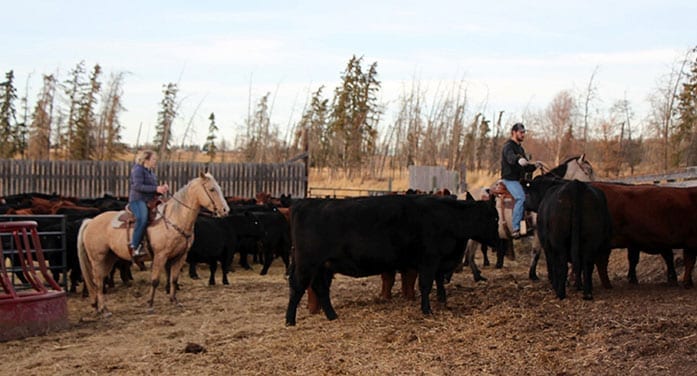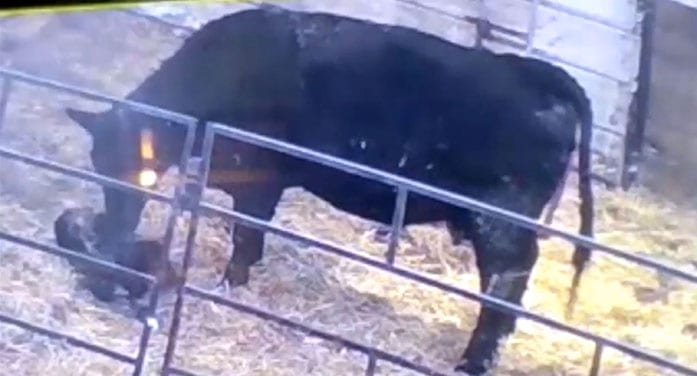Online classes during COVID-19 can feel a bit distant. But add in 48 farmers and a real-time calf birth, and things perk up considerably.
That vivid minute-by-minute experience of watching a Black Angus cow give birth was a matter of lucky timing as Jesse Emery gave University of Alberta animal science students a virtual walking tour of his Barrhead-area farm during class. But there’s no doubt it added to the attraction of a pandemic pivot that Prof. Frank Robinson made to help his students feel more engaged in the shift to online learning.
With in-person farm visits no longer an option as they had been in past Animal Science 101 courses taught in the Faculty of Agricultural, Life & Environmental Sciences (ALES), Robinson used video meetings to beef up the class, with farmers like Emery giving students live, on-the-ground reports of happenings – in this case, a perfectly timed calving.

Jesse Emery (right) herds cattle on his Barrhead-area farm. Emery is one of more than 40 Alberta farmers giving U of A animal-science students virtual tours and updates on their operations. (Photo: Supplied)
“It’s a new level of connection that goes beyond a textbook and shows this is what it’s like to be a farmer,” said Robinson.
‘It really got their attention and got them excited,” added Emery, who graduated from the U of A with a bachelor of science in agriculture and was one of the many agricultural producers from Alberta recruited by Robinson to pep up the course during the pandemic.
After COVID-19 restrictions hit, Robinson rejigged the entry-level animal agriculture course in response to feedback gathered through an ALES survey last year.
“I wondered if COVID-19 online learning could present an opportunity for me to teach differently and to do it better than I have done before.”
Asked about their biggest COVID-related teaching and learning challenges, students said they felt isolated, had difficulty feeling involved and wanted to avoid large group projects. So Robinson restructured the bachelor of science programs in agriculture and animal health course into smaller, shorter lab sessions for the winter term.
“I wanted to build smaller online groups and hopefully build the sense of community that seems to happen in this course normally in the in-person format.”
He also upped the number of farmers taking part in the course, giving students a much broader look at everything involved in livestock production.
“Normally, our students tour three to four farms in person in the term, but since that wasn’t possible, I thought, why not take this opportunity during the pandemic to have them interact with lots more farmers online?”
A wide-ranging stable of producers – many of them U of A graduates – representing the beef, swine, dairy, poultry, sheep, goat, equine, elk, bison and yak industries, guided students on virtual tours. They also made videos on biosecurity, animal welfare and other relevant industry topics, and walked the students through PowerPoint presentations describing their farm operations and what’s involved in running a livestock operation, from care and feeding to meeting marketplace standards.
“They represented a huge collective wealth of information,” said Robinson, noting that the producers seemed to be keen to share their experiences and expertise.

A Black Angus cow licks her newborn calf in a video livestreamed from Jesse Emery’s farm. U of A students witnessed the birth during their online animal science class. (Photo: Supplied)
“Our farms are our pride and joy, so it’s an easy conversation topic,” said Emery, who said he also benefited from helping out with the course.
“Being able to communicate about your farm is a good thing to practise, especially with people now more intrigued on where their food comes from. So being able to answer questions and explain things effectively helps us in the industry to communicate and close the gap between consumer and producer.”
Second-year ALES student Martin Moran was initially worried about losing the hands-on aspect of the course after it moved completely online, “but that was wiped away because although we didn’t get (near the animals physically), we got the closest to it we possibly could during the pandemic and it really gave us the ability to interact with the producers.”
As part of the course, Moran and his classmates, broken into small groups, had to develop and operate a virtual farm over eight weeks. They were mentored by a farmer, with a different theme each week. As part of that, they got some practice dealing with emergency scenarios farmers might find themselves facing, from a collapsed pig barn floor to an escaped herd of yak pounding through town.
The students scrambled to come up with quick step-by-step plans to deal with their assigned disasters. Coming from an urban background with little knowledge of livestock, Moran said it was an eye-opener.
“It really hammers home that although you can be super-prepared, you have to think on your feet as a farmer. It gives you a good idea of what the agricultural world is like. The course has shown me a whole side of food production I didn’t know about and showed this huge world of animal industry I wasn’t aware of before I got into my degree.”
Robinson hopes the amped-up course, besides giving students a richer experience amidst COVID restrictions, also boosts their understanding of the industry – a tool he believes will serve them well in any ag-related career.
“I’m hoping they’ll see that there is a place for each of them in the industry and that it sets a foundation for them to want to work with farmers more,” he said.
“Seeing students react to some of the farmers’ stories tells me that this will not be an experience they’ll forget anytime soon.”
| By Bev Betkowski for Troy Media
This article was submitted by the University of Alberta’s Folio online magazine. Folio is a Troy Media Editorial Content Provider Partner.
The views, opinions and positions expressed by columnists and contributors are the authors’ alone. They do not inherently or expressly reflect the views, opinions and/or positions of our publication.


